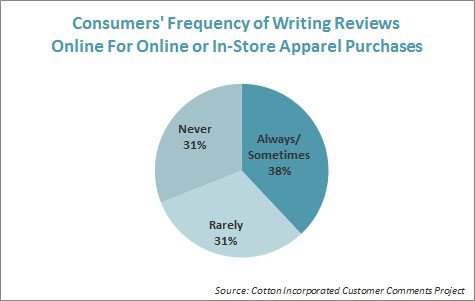Love that shirt? Write a glowing online review. Hate that shirt? Lodge an online complaint. Online reviews are now ubiquitous – and while some say that could leave a store open to abuse, experts agree it actually drives a closer relationship between retail and the consumer.
[quote]Karmaloop’s Aisha Slay, director of customer service, says the online retailer keeps extensive analytics of all online customer communication — emails, calls, chats and message boards — to help perfect its site, policies and merchandise. Issues are taken “extremely seriously,” Slay says, with reps first responding to the customer by email or phone, and then directly to the site where the feedback was posted.
“We never take the ‘wait and see’ approach with any complaint,” Slay says. “First, we try to identify and/or replicate the issue. Emails are worked 24/7 with most issues being responded to within 3-to-6 hours. If an issue is found, our merchandising team and buyers work efficiently to get it corrected. Furthermore, customer complaints and call reasons are tracked daily to monitor trends.”
More than one-third of consumers (37%) say they “always or sometimes” write product reviews online for apparel purchases made either online or in-store, up significantly from 25% in November 2010, according to the Cotton Incorporated Lifestyle Monitor™ Survey.
While (53%) of consumers say they are just as likely to write a review about a garment they were satisfied with as one they were dissatisfied with, the Cotton Incorporated Customer Comment Project reveals that approximately eight out of 10 customer ratings across all retail channels are positive.
The project looked at a collection of more than 200,000 customer comments available on the product pages of 25 key retailer websites, covering mass market retailers, chain, department and specialty stores, online-only retailers and sports specialty stores.
Kantar Retail’s Anne Zybowski, vice-president of retail insights, says comments boards are “definitely” a high priority for retailers, especially for industry leaders.
“On some boards, comments run from product-specific merchandise issues all the way to broader customer service problems and how they’re being handled,” Zybowski says. “In fashion, with so [much product] turning over so quickly, merchants look at reviews online and take action based on that. We’ve seen some retailers whose redline or clearance items correlate with a product’s negative online review.”
The quick action on the part of these retailers may be partly due to the fact that 81% of consumers say online apparel reviews are “very or somewhat” believable, and 71% say they are influential, according to the Monitor. And more than seven out of 10 consumers (71%) read product reviews right on retailer or brand websites, followed by e-commerce (45%) and social media (17%) sites.
The Doneger Group’s Tom Julian, director of strategic business development, says today’s consumer is in control, and swift retail reaction is now part of the service model.
“At recent industry workshops, many executives acknowledged the importance of real time and immediate action for all social media efforts,” Julian says. “They also say each social media platform has a different purpose: some are for buzz; others can be for retail transaction; others are for brand accolades. Executives need to have a plan and position for each.”
While most of the comments reviewed for the Customer Comment Project were favorable, denim was lowest on the positive scale, and activewear was highest.
 From 2011 to 2012, positive customer ratings for denim increased from 72% to 74%, pants increased from 76% to 77%, and activewear increased from 80% to 81%, while positive customer ratings for knit shirts declined from 80% to 78% and dresses declined from 80% to 74%.
From 2011 to 2012, positive customer ratings for denim increased from 72% to 74%, pants increased from 76% to 77%, and activewear increased from 80% to 81%, while positive customer ratings for knit shirts declined from 80% to 78% and dresses declined from 80% to 74%.
Cotton Incorporated’s Customer Comment Project also revealed consumer dissatisfaction with negative textile issues, such as shrinking, wear and tear, stretch recovery, pilling, fading, odor, wrinkling, and static cling. According to Monitor data, the majority of consumers say they are very or somewhat bothered when any of these issues occur in their garments.
Zybowski says retail response to negative comments varies from putting the product on clearance, to contacting the brand to make changes.
“They also have the option to change the product description on the product page, being more transparent about the item,” Zybowski says. “But if it’s a product quality issue, it’s a supplier or internal organization problem. To fix it, they need to go back to the R&D part of production with quality testing.”
Karmaloop says if a customer does not have a history of similar complaints, the company will immediately offer a replacement and/or compensation.
“If we receive multiple complaints regarding the same brand, we always make our buyers aware so they can reach out to the maker,” Slay says. “All our items are 100% authentic and received directly from the vendors. Although merchandising is directly responsible for maintaining consistency with sizing and quality, we work closely to ensure consumers are made aware of any and all complaints and inquiries.”
Ultimately, comment boards allow the retailer to learn more about what the consumer likes – or does not like.
“Many brands are able to monitor their customers on an ongoing basis — the number of times they’re writing, complaining, etcetera — and there is an art to data base management,” Julian says. “All information is relevant in this global, online world…and helps to connect the brand to the consumer.”
